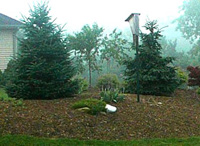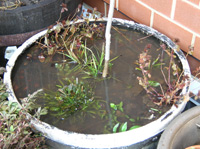Spring is a time of abundant natural moisture. The thawing ground is soaked from winter rains and snow, and rivers flood into bottomlands. Frequent showers add even more water to the mix. Gardeners are familiar with spring wetness. Low areas of the garden can be mushy or even flooded. This creates saturated soils that may be unworkable until late spring. We have to curb our enthusiasm and keep off wet grass and soggy garden soil so we don't damage it even more by walking on it.
I am currently facing this problem on an urban farm project. A space we have allotted for spring crops is in a low area that has standing water. Working that wet ground now would damage the soil structure and lead to compaction problems later. And any seeds we sow would probably rot.
Although soil is largely made up of solid particles, there are pore spaces in between the particles containing air and water. Ideal soil has about 50 percent solid matter, 25 percent water, and 25 percent air. Soil that has been wet for long periods of time -- or worked when wet — loses air in the pore spaces and becomes compacted. Plants have difficulty growing in soils without adequate pore spaces because plant roots require oxygen in the soil as well as moisture. To make matters worse, saturated soils lose many of the beneficial bacteria and organisms that promote healthy plant growth.
This is not a new problem. Farmers in the late nineteenth and early twentieth centuries often dug trenches and filled them with tiles to drain wet areas. This was a boon to agriculture, but it completely changed the local ecosystem. Today, restoration ecologists frequently remove old tile systems with the hope of restoring habitats to their natural hydrology. Fortunately, home gardeners do not usually have to resort to anything as drastic as tiling.

A berm can be a landscape feature as well as an answer to the problem of poor drainage.
The easiest way to improve drainage in a wet area is to build a berm or a raised bed directly on top of the soil. This way, the majority of the plants' roots can grow above the level of saturation. Incorporating gravel into the soil also helps improve drainage. Gardeners can also redirect gutter downspouts away from wet areas and attach them to drainage pipes that carry the water away from a low area. In severe cases of poor drainage, it may require expert help to remedy the situation.
At the urban farm, we are debating whether to bring in yards of compost to create berms or use the low area for growing rice, cranberries, and other moisture-loving crops. If the wet area is not damaging to the foundation or any other part of the property, gardeners have the option of choosing plants that like it wet. Bald cypress, river birch, swamp white oak, tupelo, willow, cyrilla, winterberry, and hibiscus are trees and shrubs that can deal with swampy conditions. Joe-pye weed, marsh marigold, swamp sunflower, lobelia, swamp milkweed, canna lily, Siberian and flag iris, crinum, and sedge are just a few of the many perennials that thrive in wet soil.

Even containers with drainage holes can get waterlogged if the holes get plugged with soil.
Compared to in-ground beds, improving drainage in containers is a simple process. First, make sure your container has drainage holes. Choose a well-draining potting mix -- garden soil is too heavy -- and add organic matter such as compost or peat moss to the soil mix. The organic amendments not only improve drainage during wet times, they also increase the moisture-holding capacity of the soil during dry times. Organic matter improves the structure of the soil, making it easier for water to flow through. Also, the individual particles of organic matter act as tiny sponges that hold water in reserve until the plant roots need it. These seemingly conflicting but beneficial properties are the reasons why I extol the virtues of organic matter.
Although standing water in the yard can be frustrating, gardeners can make adjustments. But if all else fails, defy soggy soil in low spots and grow plants -- even small trees and shrubs -- in large planters right on top of the soil. Who ever said pots need to sit on a patio or deck!